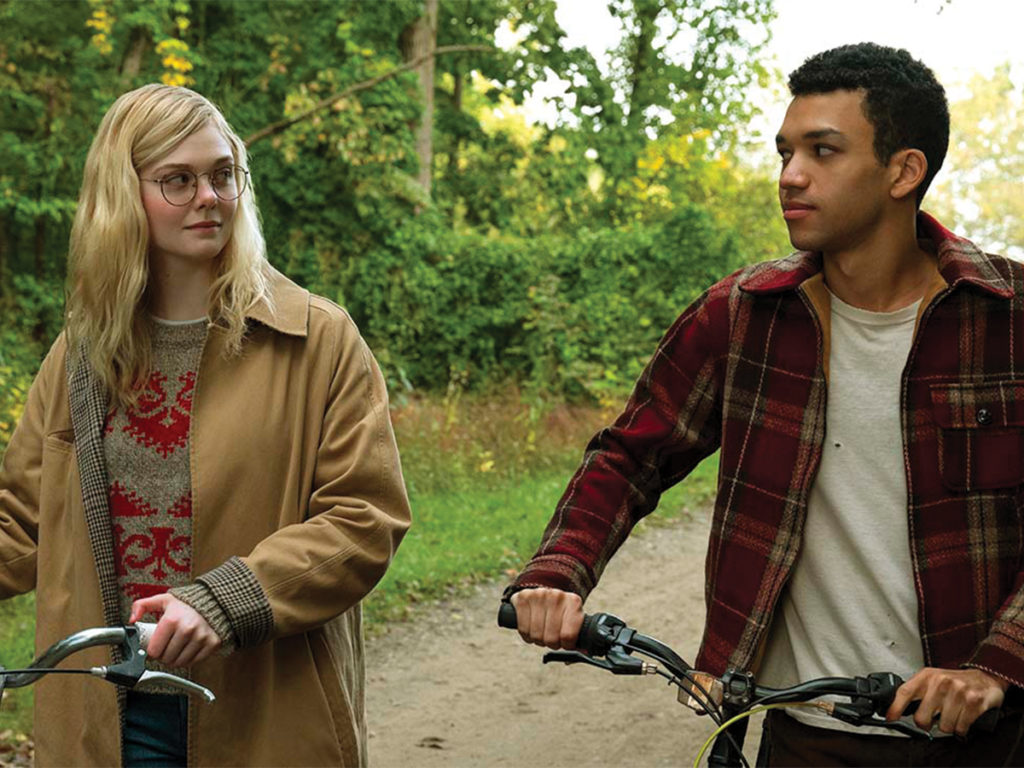
Netflix has been on a teen romance streak as of late. Following closely behind “To All the Boys I’ve Loved Before: P.S. I Still Love You,” is another young adult, fan anticipated release — “All the Bright Places,” the adaptation of Jennifer Niven’s 2015 novel of the same name. Although similar in subject matter, the two films could not be more different in execution and tone. “All the Bright Places” features a cute romantic relationship, but is a lot darker than other films Netflix has targeted toward teens. While the cinematography and soundtrack do well to exacerbate this nuanced take, the plot of the film and the characterizations are quite flawed. The impressive cast performances do not make up for the lackluster pacing or end.
The film features Violet (Elle Fanning) and Finch (Justice Smith), an unlikely couple who connect during a hopeless time of their lives. Finch helps Violet heal after a tragic event that has left her reeling, and the two embark on a mission to visit landmarks around their home state of Indiana. Unfortunately, while the premise of the film is intriguing, its execution is pretty bland. The plot has awkward pacing; certain scenes are weirdly slow while others are insanely rushed. For example, a key moment in the film, the start of Violet and Finch’s relationship, is so rushed that it doesn’t seem plausible.
The novel’s main characters were described in a New York Times review as “endearing” and praised for how they “burn brightly at the story’s gleaming center.” That same characterization is noticeably absent in the film. Violet and Finch are both dealing with serious mental health issues when they meet and the writers try hard to balance this aspect of the film with the teens’ love affair. The attempt isn’t very successful and the characterization of the pair suffers as a result. The couple shine the brightest during a charming montage that shows the progression of their budding romance as they complete a project for their high school geography class, but outside of that, their characters do not seem fully developed. This is further complicated because of the high school dynamics. Violet is popular whereas Finch is called “The Freak,” but both act out in ways that seem inconsistent with these labels. Consequently, it’s difficult for the viewer to become invested in the characters and their struggles.
Aesthetically, “All the Bright Places” is beautiful. The film deals with topics that seem to be meant more for older viewers than teenagers and adapts the tone to be subdued as such. There are plenty of quirky settings, as in most teen movies, but they are not extravagant or overly lively. This was a good choice on the part of the director and cinematographer — rural Indiana glows in the background of Violet and Finch’s romance without taking attention away from the actual characters. The soundtrack is also appropriately subtle. It is filled with slow piano melodies that can easily transition from lovestruck to mournful, which is perfect for a film that intertwines love with darker themes.
The admirable performances by Fanning and Smith lend a hand to the darker themes in the film, but they aren’t enough to make up for the pace of the plot. In a heartbreaking scene toward the end, Fanning displays an incredible range of emotions in the face of a devastating realization, but this realization is so poorly presented and hurriedly concluded that the entire film suffers as a result. The end is so abrupt that Smith’s remarkable acting in the lead up to this unexpected turn of events does little to make up for it. Even worse are the following scenes, which are surprising plot-wise and seem out of character for the downtrodden Violet, who suddenly finds peace.
The trailer promised a different, more melancholy love story; while it was satisfyingly sad, the pairing itself is not very original and small flaws work against the film. It could have been easy to become engrossed in the story if there were strong characters, but the inconsistent characterization coupled with a weirdly paced plot are a turn off. Fanning and Smith try their best to make the most out of the script, but solid performances from both are unable to distract the audience. The same can be said for the stunning views of Indiana during the fall — while very pretty to watch, they’re not enough to make up for the less striking parts of the film.
Verdict: While tantalizing, “All the Bright Places” falls short. The performances of the couple at the center were near perfect, but they were certainly not enough to make up for the rather lazy characterizations. The film is worth watching for its aesthetic value, but the plot itself either drags on or moves too quickly to keep the viewer interested.








